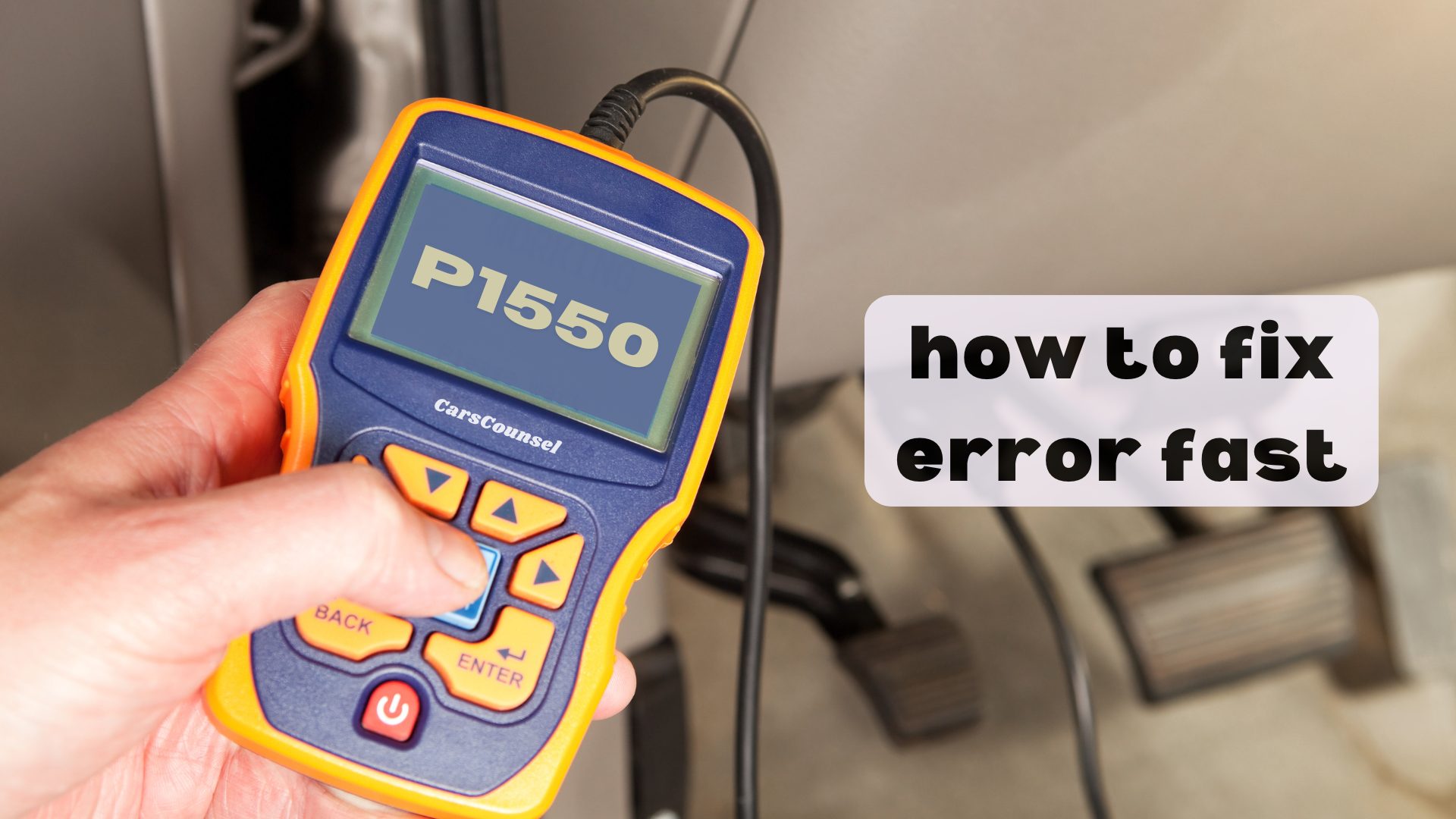If you see the P1550 code, it’s important to fix it quickly to avoid more OBD2 problems.
Start by checking your power steering fluid levels since low fluid can cause pressure issues that trigger this error.
Also, inspect the power steering pump for any leaks or strange noises, as these could mean it’s not working right.
Use a multimeter to test the power steering pressure switch and make sure it works according to the manufacturer’s guidelines.
But what if these first steps don’t solve the problem?

Quick Navigation
Key Takeaways
- Check the power steering fluid and add more if needed to keep the pressure right.
- Look at the PSP switch and replace it if it’s giving wrong pressure readings.
- Check the power steering hoses for any damage and make sure all connections are tight to stop leaks.
- Listen to the power steering pump for strange noises or look for leaks and fix any problems you find.
Understanding the P1550 Code
The P1550 code means there’s a problem with the power steering pressure (PSP) switch, which is important for keeping track of the pressure in the system and telling your car’s computer about it. When the PSP switch notices unusual pressure levels, it sets off the P1550 error code and usually turns on your check engine light. It’s important to fix this issue quickly to keep your car safe and easy to drive.
First, make sure your power steering system is working well. The P1550 code isn’t just a small issue; it points to possible steering problems that could get worse. If you ignore it, you could end up with major car problems and expensive repairs.
Regularly check your power steering parts and deal with any error codes right away to keep your car running smoothly.
Causes of the P1550 Code
Causes of the P1550 Code
Several factors can trigger the P1550 code, each pointing to specific issues within the power steering system. Understanding these causes helps you address the problem efficiently.
| Cause | Explanation | Solution |
|---|---|---|
| Faulty Power Steering Pressure (PSP) Switch | Incorrectly detects pressure, triggering the code | Replace the PSP switch |
| Low Power Steering Fluid | Low levels or poor quality can cause pressure drops | Add or replace power steering fluid |
| Worn Power Steering Pump | Damage to the pump affects pressure, especially in older systems | Replace the power steering pump |
A bad PSP switch, low-quality fluid, or an old pump can all cause problems in the power steering system. Address each issue one by one to fix the P1550 code quickly.
Affected Car Models
Many cars, like the Chevy Silverado and Honda Civic, often get the P1550 code because of problems with their power steering systems.
The Chevy Silverado usually has issues with its TAC system, while the Honda Civic often has trouble with its power steering pump.
The Honda Accord and Toyota Camry also have similar problems with their steering pumps and hoses.
The Nissan Altima isn’t free from issues either, as it faces design-related power steering problems.
Newer car models might have better parts that reduce the chances of getting the P1550 code.
Always check for updated parts and repair methods that are specific to your car.
This way, you can fix the main problem more effectively.
Checking Power Steering Fluid
Start by finding the power steering fluid reservoir. It usually has a steering wheel icon on it or is labeled ‘Power Steering Fluid.’ Keeping an eye on your power steering fluid is important for making sure everything works smoothly.
Follow these steps:
- Check Fluid Level: Take off the reservoir cap and use the dipstick to see how much fluid is in there. It should be between the ‘MIN’ and ‘MAX’ marks.
- Add Fluid if Needed: If the fluid is low, add the right type of power steering fluid recommended by the manufacturer. Be careful not to overfill it.
- Inspect for Leaks: Look around the reservoir and hoses for any signs of fluid leaks, which might need more attention.
Regularly checking the fluid level can prevent power steering issues and help you avoid the P1550 error code.
Inspecting Power Steering Pump
After checking the fluid, take a look at the power steering pump to make sure it’s working right. Start by checking for any leaks around the pump, as this is a common sign that something is wrong. Then, listen for any strange noises like whining or grinding, which could mean there’s internal damage. Make sure the pump pulley turns smoothly without any resistance.
| Inspection Step | Action |
|---|---|
| Check for leaks | Look around the pump for any fluid leaks. |
| Listen for noises | Start the engine and listen for whining sounds. |
| Inspect pulley function | Turn the pulley by hand to ensure it moves smoothly. |
| Check mounting bolts | Make sure all the bolts are tight and secure. |
These steps help ensure your power steering system is in good shape and assist in maintaining the pump. If you find any problems, you might need to repair or replace the pump.
Testing the PSP Switch
Testing the PSP switch can be done easily with a multimeter to check the voltage at the switch connector. Here are the steps for accurate testing:
- Turn Off the Engine: Make sure your car is off and the key is out of the ignition. This helps avoid any electrical issues.
- Set Up Multimeter: Set your multimeter to measure voltage. Connect the red lead to the positive terminal and the black lead to the ground on the PSP switch connector.
- Check Voltage: With the multimeter connected, turn the key to the ON position without starting the engine. Check the voltage reading on the multimeter. A steady reading within the range specified by the manufacturer means the PSP switch is working properly.
Using the multimeter correctly ensures you can diagnose and fix the P1550 code effectively.
Examining Hoses and Connections
When checking the power steering hoses and connections, you’re looking for leaks, damage, or loose fittings that might affect pressure.
First, make sure the car is on a flat surface with the engine off.
Start by looking at each hose for cracks or wear. Bend the hoses gently to find any hidden damage.
Then, check if the connections are tight. Use a flashlight to see areas that are hard to reach.
Wipe any wet spots to spot new leaks. If you find any damage or loose connections, replace them right away.
Keeping the hoses and connections in good shape is important to avoid pressure drops that can cause the P1550 code.
Consulting a Mechanic
When dealing with ongoing P1550 code issues, it’s a good idea to talk to a mechanic who has the right tools to find and fix the problem. Make sure the mechanic knows how to work on your car’s power steering system.
Here’s a simple guide:
- Check Mechanic’s Skills: Look into the mechanic’s certifications and experience with power steering systems.
- Use the Right Tools: The mechanic should use advanced tools to find out exactly what’s wrong with the power steering system.
- Trust the Mechanic’s Advice: Follow their recommendations for any repairs or parts that need replacing.
Replacing PSP Switch
How to Replace the PSP Switch
- Disconnect the negative battery cable to ensure safety.
- Find the PSP switch, usually located on the power steering pump.
- Unplug the electrical connector from the switch.
- Use the right wrench to unscrew and remove the faulty PSP switch.
- Screw in the new PSP switch and tighten it securely.
- Reconnect the electrical connector.
- Reattach the negative battery cable.
After installing the new PSP switch, start your car and check for any remaining power steering issues to make sure everything is working correctly.
Routine Maintenance Tips
After you install the new PSP switch, make sure your power steering system works smoothly by following these simple maintenance tips. Regular care helps prevent problems and keeps everything running well.
- Regular Checks: Look at the power steering fluid levels every month. Check for leaks and add fluid if needed.
- Preventive Steps: Check the power steering hoses and connections every six months. Replace any parts that are damaged or worn out right away.
- Pump Care: Listen for any strange noises from the power steering pump. If you hear whining or groaning, get it checked immediately.
More OBD-II Codes
Frequently Asked Questions
Can a P1550 Code Cause My Car to Fail an Emissions Test?
Yes, a P1550 code can make your car fail an emissions test. Emissions rules require everything to work right. Follow the steps to find and fix the problem before your test.
What Tools Do I Need to Diagnose the P1550 Code Myself?
Imagine your car is a ship in rough waters; you need the right tools to steer it safely. You’ll need some basic diagnostic tools: a multimeter to test the PSP switch, a fluid gauge to check fluid levels, and your eyes to inspect the hoses.
How Long Can I Drive With the P1550 Code Before It Causes Major Damage?
You shouldn’t drive for long with the P1550 code. It can lead to steering problems, higher repair costs, and unsafe driving conditions. Fix it right away to prevent serious damage and ensure your safety on the road.
Will Fixing the P1550 Code Improve My Car’s Fuel Efficiency?
Fixing this problem will make your car use fuel more efficiently and run better. Start by checking the power steering system, replace any broken parts, and make sure the fluid levels are right. This will help your car run more smoothly and save on gas.
Are There Any Temporary Fixes for the P1550 Code Until I Can Get to a Mechanic?
For a quick fix, make sure the power steering fluid is topped off. Look for leaks in the hoses and tighten any loose connections. These steps can help keep things running smoothly until you can get to a mechanic.
Conclusion
You’ve checked the power steering fluid, looked at the pump, examined the hoses, and even tested the PSP switch.
But what if the P1550 code is still showing up? Don’t worry. The next thing to do is to see a mechanic. They can find hidden issues you mightn’t have noticed.
Regular maintenance is key to avoiding this annoying code. So, stay alert and keep your car in good condition. Your car’s performance depends on it.
Ready to take the next step?

